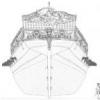-
Posts
213 -
Joined
-
Last visited
Reputation Activity
-
 Bender got a reaction from riverboat in San Felipe by Bender - Mantua/Panart --Scale 1:75--Rebuild Log
Bender got a reaction from riverboat in San Felipe by Bender - Mantua/Panart --Scale 1:75--Rebuild Log
A few more pictures.
The planking at the lower gun deck.
Some paint applied.
-
 Bender got a reaction from riverboat in San Felipe by Bender - Mantua/Panart --Scale 1:75--Rebuild Log
Bender got a reaction from riverboat in San Felipe by Bender - Mantua/Panart --Scale 1:75--Rebuild Log
From a post made on May 9, 2009.
For the round holes I first drilled a hole in the center, second I filed the hole bigger, third I used a piece of 8mm dowel with sandpaper glued around it to make the hole bigger, and fourth I used a piece of 10mm dowel with sandpaper to finish rounding the hole to size. I worried too much about the gun port in my pervious post. Back to the planking ply. The top run of planking ply is attached first. I measured and rechecked my measurement three times just to make sure I placed it in the correct spot. Then a single 1x6 walnut strip with two 2x2 walnut rubbing strakes were attached. The second run of planking ply went on followed by a single 1x6 strip and two 2X3 walnut rubbing strakes. The third run of planking ply had to be bent around the bow. It did not want to bend. I was afraid if I heated or dampened the strip the plies would separate. I finally gave in and heated the strip—and the plies did separate. This worked out okay. The strip bent easily, and after gluing the plies back together, the strip held it curved shape. Next, I will start the rest of the hull planking. It will take 20 strips on each side to finish the hull.
Drilled a hole first
Filed the hole bigger.
8mm dowel with sandpaper glued around it to make the hole a little bigger
10mm dowel with sandpaper to finish rounding the hole to size.
The next two pictures show what it looked like with the first strip of planking plywood.
The next two pictures show what it looked like with two strips of planking plywood and the two rubbing strakes.
-
 Bender got a reaction from riverboat in San Felipe by Bender - Mantua/Panart --Scale 1:75--Rebuild Log
Bender got a reaction from riverboat in San Felipe by Bender - Mantua/Panart --Scale 1:75--Rebuild Log
This is from a post made on May 9, 2009:
The second planking begins. The second planking from the gun port up is laser engraved plywood. Walnut strips will cover the hull below the gun ports. Each strip of planking plywood is 18 mm wide or wider and is engraved to look like three or more planks. The gun ports are laser cut so that each strip of planking plywood serves as a template to cut the gun port hole. For the 62 ports below the decks, I had only the first planking of balsa to cut out. Those ports gave me no trouble. For the ports above the decks—which includes the round ports—I had the balsa and the walnut strips along the inside of the bulwarks to cut out. The rectangular ports went well enough. I went through several exacto blades.
The first strip on planking plywood clamped
Clamps off
A view of deck. Note the deck planking is also finished at this point. I'll talk about that later.
-
 Bender got a reaction from riverboat in San Felipe by Bender - Mantua/Panart --Scale 1:75--Rebuild Log
Bender got a reaction from riverboat in San Felipe by Bender - Mantua/Panart --Scale 1:75--Rebuild Log
This is from a post made on May 2, 2009.
I spent a few days sanding the high spots and puttying the low spots. After finishing the first planking of balsa I sanded the hull down, and then following the Mantua direction, I coated the entire hull with a mixture of white glue and water 30/70. This made the hull a little more firm. The glue/water mixture seems to soak into the balsa wood. Then I scraped some putty in the low spots, sanded the entire hull again, putty a few more low spots, and then sanded one more time.
Next is cutting the handrail profile and cutting the 86 rectangular, 12 circular, and 4 semicircular gun ports. Later there will be 2 more gun ports at the bow and 4 under the curve of the stern to cut.
-
 Bender got a reaction from riverboat in San Felipe by Bender - Mantua/Panart --Scale 1:75--Rebuild Log
Bender got a reaction from riverboat in San Felipe by Bender - Mantua/Panart --Scale 1:75--Rebuild Log
This is from a post made of April 26, 2009.
I had my first major take apart and redo on The San Felipe. At the stern of the ship there are three thin plywood flaps that stick on like tailfins of a fish. The top two are terraces. Planking is laid vertically between the middle and bottom flaps, so that the bottom flap would be part of the ship’s interior. (Maybe the officers’ toilet facilities???) I glued about fifty pieces of balsa and when the glued dried, I trimmed of the excess balsa. This is when I noticed the problems. (Sorry no pictures of this foul up. The last thing on my mind was taking pictures. I was thinking what the ding dang did I do wrong?) When looking at the ship from the rear, the vertically planked area between the middle and bottom flaps was wider from top-to-bottom on the right than the left. I couldn’t tell if the bottom flap was drooping or if the middle flap was getting higher. After measuring I realized it was a little of both. I took off all the vertical planks and glued balsa blocks between the middle and bottom flaps and clamped. This took care of the drooping bottom flap but the middle flap pulled loose from the balsa and arched back up. The left side was okay, so I re-planked just past center. Again I clamped the middle and bottom flaps together, but this pulled the bottom flap up instead of pulling the middle flap down. I always think clamp together, never push apart, but pushing apart was the answer. I wedged some scrap between the top and middle flaps. There is a picture of this below, but it is hard to tell the scrap from the ship’s frame. With the middle flap down where it was suppose to be, I finished gluing the vertical planks. The scrap wedge stayed in until the next day. I wanted to make sure the glue was dry. I also had to remove one plank from the curve under the stern and replace it after the vertical pieces were trimmed.
Vertical planks between the middle and bottom flaps. (Before seeing the foul up.)
All of the vertical strips were removed. The flip was held in place while the left side was re-planked. I filled the gap with more balsa blocks and clamped. When I remove the clamp the flap pulled loose.
Notice the piece of scrap (it appears whiter than the other wood) wedged between the top and middle flaps. This piece of scrap is holding the middle flap down while the glue dries on the vertical pieces of planks.
Trimmed and sanded aft end. Also showing the replaced plank under the curve of the stern.
-
 Bender got a reaction from riverboat in San Felipe by Bender - Mantua/Panart --Scale 1:75--Rebuild Log
Bender got a reaction from riverboat in San Felipe by Bender - Mantua/Panart --Scale 1:75--Rebuild Log
This post was originally made on April 25, 2009.
The first planking is well underway, and I have stayed with the kit’s directions. As mentioned to Chrism in the previous post, I am using balsa for the first planking. The balsa is easy to work with: easy to cut, easy to bend, easy to trim to the needed shape. I did have one problem with the balsa when I was building the Royal Caroline. I used map pins to hold the second planking of walnut against the balsa, but the balsa was too soft in a few spots to hold the pin in tightly. It was not a big problem. CA glue took care of it. Back to the San Felipe. I lack under the curve at the stern and the vertical pieces under the lower terrace at the stern. After that, a day or two of sanding awaits me. Then the part I am dreading: cutting the profile of the handrails and cutting the cannon ports.
Later on I had to remove these vertical pieces.
-
 Bender got a reaction from edmay in San Felipe by Bender - Mantua/Panart --Scale 1:75--Rebuild Log
Bender got a reaction from edmay in San Felipe by Bender - Mantua/Panart --Scale 1:75--Rebuild Log
I am really pleased with the way the frame went together. There were no adjustments needed. The frame and stiffeners are designed in such a way that it would be nearly impossible for the bulkheads
not to be square with the false keel. I have nothing but praise for Mantua/Panart for the design of the kit. The directions are a different matter. The instruction/picture book does not have the same directions as the large sheet. For instance: the instruction/picture book has the dummy cannon blocks mounted horizontally along the stiffeners, where as the large sheet has the dummy cannon blocks mounted vertically across the stiffeners. And sometimes the instruction/picture book doesn’t agree with itself. From the instruction/picture book: Step 19 shows frame 1b in place, and later in step 28 it shows the placement of deck 22a, but frame 1b must be mounted on top of deck 22a. All this makes the build that much more interesting. It appears that the kit I bought is a newer version of San Felipe. I emailed Mantua; here’s there reply
referring to 747:
if you have the latest model, you can see from the new color picture instruction, you have to follow
them, considering the large plan an help but not a building indication. Please let us know the
number of the last picture of the manual. On internet we have put the last updated version.
regards MM
So, I looked at Mantuahelp.com, and the online directions are also a mix of the old and newer version of instructions. I’ve read many times here on Model Ship World: Read the directions over and over and make a plan. Even with the wacky directions, I am still very pleased with the kit.
Contents scattered across the floor.
Direction from the large sheets showing the cannon blocks mounted vertically.
Direction from instruction/picture book showing cannon blocks mounted horizontally.
Frame and stiffeners with dummy cannon blocks mounted horizontally.
Dummy cannon blocks are painted black.
Starting the first layer of planking.
-
 Bender got a reaction from edmay in San Felipe by Bender - Mantua/Panart --Scale 1:75--Rebuild Log
Bender got a reaction from edmay in San Felipe by Bender - Mantua/Panart --Scale 1:75--Rebuild Log
I tapered the frames. The directions said to file the first four and the last three. I took some pictures, but you couldn’t tell they were tapered. The directions were specific on the planking. I’m following them as close as possible. I included two pictures. Notice the little pieces of planking pinned to bulkhead-six. The picture/directions suggested to use this technique to assure proper blank layout.
The San Felipe had porticos (balconies) on two levels the wrapped around the stern. The decks for these porticos had to be added as the planking was attached.
-
 Bender got a reaction from riverboat in San Felipe by Bender - Mantua/Panart --Scale 1:75--Rebuild Log
Bender got a reaction from riverboat in San Felipe by Bender - Mantua/Panart --Scale 1:75--Rebuild Log
The following was originally posted June 19, 2009.
When something does not line up, the first words out of my mouth is, “What did I do wrong?” As you can see from the first four photos, the bell and its little house do not fit into its position. The deck above is sitting too far over. It could not be the main deck out of position because notches in the false deck sit in the break-off tabs on the bulkheads. The deck above sits in a notch of the front bulk head.
So, as I thought about it further, I realized that if I glued in a deck out of position then there would be more misalignments. Everything else lines up. The holes in the two decks for the foremast line up. The next question is, did I position everything on the main deck in the correct place? Position of everything on all the decks are dummy proof. The decks are laser engraved. There is a square engraved on the deck where the bell is to be position and a hole for the gratings right behind the bell. So my conclusion: ?????? Could Mantua have made a mistake like this during their revision of this kit? I ended up having to cut out a portion of the upper deck. When the bell is in place you can’t tell the upper deck has been altered. No harm, no foul.
Now 5 years later I am still not sure if I made a mistake or if the kit had a problem. Looking at the finished model now you cannot tell anything is misaligned. If anyone is building this newer version of San Felipe, let me know if you have the same issues or not. I am curious.
In the next two pictures you can see there is not enough room to slide the bell house up against the grating.
This is where I had to cut the upper deck so the bell house
would fit. The hole is actually centered. It looks like I was holding the camera a little off center.
The bell house sitting in place.
-
 Bender got a reaction from riverboat in San Felipe by Bender - Mantua/Panart --Scale 1:75--Rebuild Log
Bender got a reaction from riverboat in San Felipe by Bender - Mantua/Panart --Scale 1:75--Rebuild Log
The following was originally posted May 29, 2009.
I lined the cannon ports this week. The top sides, round ports were lined already. The main deck ports have brass inserts on the outside and frames on the inside. The lower two decks have 58 gun ports that I lined with .5x3 walnut. I painted the strips red before cutting to size. There are 4 more ports below the curve at the stern that I have not cut yet. I also glued on some of brass. Each piece of brass had to have bits clipped off and then filed to shape. There is still a lot of brass left to glue on.
-
 Bender got a reaction from newbuilder101 in San Felipe by Bender - Mantua/Panart --Scale 1:75--Rebuild Log
Bender got a reaction from newbuilder101 in San Felipe by Bender - Mantua/Panart --Scale 1:75--Rebuild Log
The following was originally posted June 19, 2009.
When something does not line up, the first words out of my mouth is, “What did I do wrong?” As you can see from the first four photos, the bell and its little house do not fit into its position. The deck above is sitting too far over. It could not be the main deck out of position because notches in the false deck sit in the break-off tabs on the bulkheads. The deck above sits in a notch of the front bulk head.
So, as I thought about it further, I realized that if I glued in a deck out of position then there would be more misalignments. Everything else lines up. The holes in the two decks for the foremast line up. The next question is, did I position everything on the main deck in the correct place? Position of everything on all the decks are dummy proof. The decks are laser engraved. There is a square engraved on the deck where the bell is to be position and a hole for the gratings right behind the bell. So my conclusion: ?????? Could Mantua have made a mistake like this during their revision of this kit? I ended up having to cut out a portion of the upper deck. When the bell is in place you can’t tell the upper deck has been altered. No harm, no foul.
Now 5 years later I am still not sure if I made a mistake or if the kit had a problem. Looking at the finished model now you cannot tell anything is misaligned. If anyone is building this newer version of San Felipe, let me know if you have the same issues or not. I am curious.
In the next two pictures you can see there is not enough room to slide the bell house up against the grating.
This is where I had to cut the upper deck so the bell house
would fit. The hole is actually centered. It looks like I was holding the camera a little off center.
The bell house sitting in place.
-
 Bender got a reaction from newbuilder101 in San Felipe by Bender - Mantua/Panart --Scale 1:75--Rebuild Log
Bender got a reaction from newbuilder101 in San Felipe by Bender - Mantua/Panart --Scale 1:75--Rebuild Log
The following was originally posted May 29, 2009.
I lined the cannon ports this week. The top sides, round ports were lined already. The main deck ports have brass inserts on the outside and frames on the inside. The lower two decks have 58 gun ports that I lined with .5x3 walnut. I painted the strips red before cutting to size. There are 4 more ports below the curve at the stern that I have not cut yet. I also glued on some of brass. Each piece of brass had to have bits clipped off and then filed to shape. There is still a lot of brass left to glue on.
-
 Bender got a reaction from riverboat in San Felipe by Bender - Mantua/Panart --Scale 1:75--Rebuild Log
Bender got a reaction from riverboat in San Felipe by Bender - Mantua/Panart --Scale 1:75--Rebuild Log
Here are the pictures of the braces under the beakhead deck.
-
 Bender got a reaction from riverboat in San Felipe by Bender - Mantua/Panart --Scale 1:75--Rebuild Log
Bender got a reaction from riverboat in San Felipe by Bender - Mantua/Panart --Scale 1:75--Rebuild Log
-
 Bender got a reaction from riverboat in San Felipe by Bender - Mantua/Panart --Scale 1:75--Rebuild Log
Bender got a reaction from riverboat in San Felipe by Bender - Mantua/Panart --Scale 1:75--Rebuild Log
Hi, Salty Dog. The directions were not the best. See the post I made on the first page that shows where the sheets of plans differed from the direction book.
The following was originally posted May 2009.
I trimmed out the very front of the ship, the beakhead deck and round houses. The crew’s toilet was supposed to be a three-whole seat, but I couldn’t image sitting cheek to cheek with two other guys while taking care of business. No actually, after six tries of trying to drill three 3mm holes through a piece of 2x6x14 walnut, I gave up and went for a two-hole seat. I ask about the roundhouses and toilet in one of the question forum, and Dinosaursoupman made this commit: “In rough seas [The seats of ease] doubled as bidets.” What an image!
I put two of the three pairs of braces under the beakhead deck and will add the third this week. I have also glued on more of the brass parts. This week I plan to start lining the gun ports or maybe work at the stern of the ship..
After reading the above I went out to to see if I could make the three 3mm holes using my drill press. No problems. The right tool does make a difference. Here are some of the pictures from this part of the building.
-
 Bender got a reaction from riverboat in San Felipe by Bender - Mantua/Panart --Scale 1:75--Rebuild Log
Bender got a reaction from riverboat in San Felipe by Bender - Mantua/Panart --Scale 1:75--Rebuild Log
Steve, here is a good picture of the laser engraved deck. I think this was after I applied a coat of a stain but thought it was too dark and ended up sanding back to bare wood.
-
 Bender got a reaction from md1400cs in Reale de France by Bender - FINISHED - Corel - Scale 1:75
Bender got a reaction from md1400cs in Reale de France by Bender - FINISHED - Corel - Scale 1:75
The boat rack was made earlier in the build.
-
 Bender got a reaction from Aussie048 in San Felipe by Bender - Mantua/Panart --Scale 1:75--Rebuild Log
Bender got a reaction from Aussie048 in San Felipe by Bender - Mantua/Panart --Scale 1:75--Rebuild Log
-
 Bender got a reaction from Aussie048 in San Felipe by Bender - Mantua/Panart --Scale 1:75--Rebuild Log
Bender got a reaction from Aussie048 in San Felipe by Bender - Mantua/Panart --Scale 1:75--Rebuild Log
Hi, Salty Dog. The directions were not the best. See the post I made on the first page that shows where the sheets of plans differed from the direction book.
The following was originally posted May 2009.
I trimmed out the very front of the ship, the beakhead deck and round houses. The crew’s toilet was supposed to be a three-whole seat, but I couldn’t image sitting cheek to cheek with two other guys while taking care of business. No actually, after six tries of trying to drill three 3mm holes through a piece of 2x6x14 walnut, I gave up and went for a two-hole seat. I ask about the roundhouses and toilet in one of the question forum, and Dinosaursoupman made this commit: “In rough seas [The seats of ease] doubled as bidets.” What an image!
I put two of the three pairs of braces under the beakhead deck and will add the third this week. I have also glued on more of the brass parts. This week I plan to start lining the gun ports or maybe work at the stern of the ship..
After reading the above I went out to to see if I could make the three 3mm holes using my drill press. No problems. The right tool does make a difference. Here are some of the pictures from this part of the building.
-
 Bender got a reaction from Aussie048 in San Felipe by Bender - Mantua/Panart --Scale 1:75--Rebuild Log
Bender got a reaction from Aussie048 in San Felipe by Bender - Mantua/Panart --Scale 1:75--Rebuild Log
Here are the pictures of the braces under the beakhead deck.
-
 Bender got a reaction from dragzz in San Felipe by Bender - Mantua/Panart --Scale 1:75--Rebuild Log
Bender got a reaction from dragzz in San Felipe by Bender - Mantua/Panart --Scale 1:75--Rebuild Log
Here are the pictures of the braces under the beakhead deck.
-
 Bender got a reaction from WackoWolf in San Felipe by Bender - Mantua/Panart --Scale 1:75--Rebuild Log
Bender got a reaction from WackoWolf in San Felipe by Bender - Mantua/Panart --Scale 1:75--Rebuild Log
Hi, Salty Dog. The directions were not the best. See the post I made on the first page that shows where the sheets of plans differed from the direction book.
The following was originally posted May 2009.
I trimmed out the very front of the ship, the beakhead deck and round houses. The crew’s toilet was supposed to be a three-whole seat, but I couldn’t image sitting cheek to cheek with two other guys while taking care of business. No actually, after six tries of trying to drill three 3mm holes through a piece of 2x6x14 walnut, I gave up and went for a two-hole seat. I ask about the roundhouses and toilet in one of the question forum, and Dinosaursoupman made this commit: “In rough seas [The seats of ease] doubled as bidets.” What an image!
I put two of the three pairs of braces under the beakhead deck and will add the third this week. I have also glued on more of the brass parts. This week I plan to start lining the gun ports or maybe work at the stern of the ship..
After reading the above I went out to to see if I could make the three 3mm holes using my drill press. No problems. The right tool does make a difference. Here are some of the pictures from this part of the building.
-
 Bender got a reaction from WackoWolf in San Felipe by Bender - Mantua/Panart --Scale 1:75--Rebuild Log
Bender got a reaction from WackoWolf in San Felipe by Bender - Mantua/Panart --Scale 1:75--Rebuild Log
-
 Bender got a reaction from Adrieke in Tying blocks to yards or masts.
Bender got a reaction from Adrieke in Tying blocks to yards or masts.
I am not very good at drawing but . . .
The last four pictures shows different places I have used this method.
Around a yard.
Under a top. These blocks were added by passing the thicker thread around the cross tree before doing any warping.
All of these blocks are attached with this method. I used a variation of this method to attach the stay.
And one more
I lied. One more.
-
 Bender got a reaction from cor_f in Tying blocks to yards or masts.
Bender got a reaction from cor_f in Tying blocks to yards or masts.
I am not very good at drawing but . . .
The last four pictures shows different places I have used this method.
Around a yard.
Under a top. These blocks were added by passing the thicker thread around the cross tree before doing any warping.
All of these blocks are attached with this method. I used a variation of this method to attach the stay.
And one more
I lied. One more.










